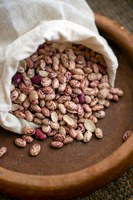Prairie Fare: Love beans? Skip the symphony
(Click an image below to view a high-resolution image that can be downloaded)
“I was thinking about grilling,” my husband texted me. “How about beans as a side dish?”
“That sounds great,” I said.
Evidently, he was not worried about beans’ reputation as “the musical fruit.”
We aren’t having guests, I thought to myself. We have plenty of room in our home to find an isolated area.
I am joking about isolating ourselves. Kind of.
Actually, the more beans you eat, the less your tendency to toot. We eat beans very regularly in our home.
Despite the “beans, beans — the musical fruit” rhyme, beans are not a fruit. Beans count as a vegetable or a member of the protein group; however, coming up with a clever rhyme for either of those food groups would be challenging.
All types of dry edible beans, from black beans to navy beans, are in the category called pulses, which also includes lentils and split peas. On an even broader scale, pulses are part of the “Leguminosae” (legume) family that includes peanuts, soybeans, fresh beans and fresh peas.
Why do beans promote gas in some people?
Beans are high in fiber, which is good for our digestion. Many of us shortchange ourselves on fiber intake. Insoluble fiber helps prevent constipation, and soluble fiber may lower our blood cholesterol level and decrease our risk for heart disease.
Beans contain natural sugars called “oligosaccharides.” These sugars, including stachyose, raffinose and verbascose, are not easily broken down by our digestive system.
We all have natural, helpful bacteria in our gut. The bacteria inside us number in the trillions.
The healthy bacteria inside us need to eat, too, and they dine on “prebiotics” found naturally in beans, garlic, onions, bananas, whole grains and other foods. Probiotic foods, such as yogurt and fermented food, also promote good gut health.
When the remnants of food travel through our bodies during digestion, undigestible sugars reach our large intestine. Bacteria in the gut ferment these sugars and produce hydrogen, carbon dioxide and methane gas after eating some gas-producing foods.
Although these gases are not exactly perfume-like, several health benefits are associated with both oligosaccharides and fiber. Many studies have shown that eating more beans and other pulse foods may reduce our risk of colon cancer, diabetes, high blood pressure and high blood cholesterol.
Pulse foods are an economical addition to our diets. You can do a few things to reduce the tendency of beans to make you musical after dining on high-fiber foods.
Dry beans are more economical than canned, but both are nutritional bargains. After rinsing, canned beans do not require any further preparation.
Follow the correct procedures when preparing dry beans. After inspecting beans, removing the broken beans and small stones (if present), rinse them in cold water.
Next, soak them as directed. Use 10 cups of cold water to soak each pound of beans. Bring the water to a boil and boil for two to three minutes, then remove from the burner, cover the pot and allow the pot to stand for four hours. Many of the gas-producing compounds are released into the soaking and cooking water that is discarded.
Next, drain and rinse the soaked beans, add fresh water and cook for about an hour, depending on the bean type, until the beans are tender. This will yield about 4 to 5 cups of cooked beans.
If you have decided to add more beans to your diet, start slowly with two to four tablespoons of beans per day. Be sure to drink more water and chew food well to promote digestion. You might try an over-the-counter medication.
Beans can be used in salads, main dishes, salads and snacks. In baked goods, pureed beans can be used to replace half of the fat, but follow a tested recipe to ensure good results.
If you are interested in learning more, visit the NDSU Extension Field to Fork website at www.ag.ndsu.edu/fieldtofork and scroll to the bean resources. Check out the “Spillin’ the Beans” cookbook and the “All About Beans” handout. Here’s one of the popular recipes from the cookbook:
Black Bean Brownies
1 (15.5-ounce) can black beans, drained and rinsed
3 eggs
3 tablespoons vegetable oil
¼ cup cocoa powder
1 pinch salt
1 teaspoon vanilla extract
¾ cup white sugar
1 teaspoon instant coffee (optional)
½ cup semisweet chocolate chips
Preheat oven to 350 F. Lightly grease an 8-by-8-inch baking dish. Combine all ingredients except chocolate chips in a blender; blend until smooth; pour mixture into prepared baking dish. Sprinkle with chocolate chips. Bake in preheated oven until the top is dry and sides start to pull away from the baking dish, about 30 minutes.
Makes 16 servings. Each serving has 140 calories, 6 grams (g) fat, 3 g protein, 20 g carbohydrate and 105 milligrams sodium.
(Julie Garden-Robinson, Ph.D., R.D., L.R.D., is a North Dakota State University Extension food and nutrition specialist and professor in the Department of Health, Nutrition and Exercise Sciences.)
NDSU Agriculture Communication – May 15, 2025
Source: Julie Garden-Robinson, 701-231-7187, julie.garden-robinson@ndsu.edu
Editor: Dominic Erickson, 701-231-5546, dominic.erickson@ndsu.edu




